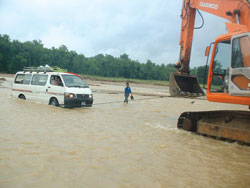|
|
| FLOOD OF TEARS: The ill-fated microbus is pulled out of the flooded Dhansar river in Rautahat the morning after five people perished. |
The microbus carrying a newly-wed couple and their relatives left Dhankuta on Saturday afternoon for the overnight journey to Kathmandu.
It was important to cross the troubled eastern tarai at night, despite the danger of highway robberies, because of road blockades and disruptions in the daytime. There was a banda call for Sunday, and the wedding group was in a hurry to cross the plains by midnight.
By the time the bus reached Chandranighapur in Rautahat, it was 10PM and raining heavily. A little ahead, hundreds of vehicles were queued up by the side of the highway in the dark because the bridge over the Dhansar river had been washed away three days previously.
Trucks were fording the river even though the water came up to tyre height. Driver Anil Tamang saw a passenger bus go across and decided to give it a try. But the microbus got stuck mid-river.
As the bus headlamps illuminated the swollen river, the passengers got out to push. Just then a flashflood engulfed the vehicle. The newlyweds, Raju and Kimila Shrestha, and two other passengers held on to the roof, but five others were washed away with logs and other debris that the river brought down. Their bodies were found up to 10km downstream the next day.
This would have been just another tragedy on Nepal's accident prone highways had it not been for the circumstances that lead to the deaths. This wasn't an accident: it was the result of corruption, war and government negligence. Also, the microbus probably wouldn't have been travelling at night if the tarai unrest hadn't made daytime journeys so unpredictable.
A 50m section of the bridge on the Dhansar on the East-West Highway, Nepal's main road artery, was knocked out by a flood three years ago. Makeshift repairs allowed it to keep functioning while wheeling dealing on the contract delayed construction of a new bridge.
The work had just begun at the height of the Maoist war in 2004 when guerrillas demanded Rs 1.5 million from the contractor. He said he couldn't pay, and work stopped after three of the pillars were completed. After the ceasefire last year construction resumed but the contractor faced extortion again, this time by the Jwala faction of the JTMM. Work was halted once more.
On the night of 5 September there was a massive storm upstream in the Chure hills, and the flood washed away the same section of the Dhansar bridge once more. For four days, there was no effort to repair the damage or warn buses on the highway of the broken bridge. Whenever the water receded, passengers would make the perilous crossing on foot to catch a bus on the other side.
The microbus arrived at the broken bridge and seeing a bus making it safely across, took the fateful decision to cross.
This isn't the first time a bus has been washed away by flooded rivers, and it won't be the last. Sometimes it is a casualty of war as in last weekend's tragedy in Rautahat, at others it is because disagreement over kickbacks has delayed repairs. Interestingly, the Road Department rushed equipment and repaired the bridge the day after the tragedy, just to prove how quickly it could act if it wanted to.
This tragedy was proof that corruption kills. Negligence can be fatal. And the sorrow of war lingers long after the fighting stops.
Kunda Dixit in Rautahat



